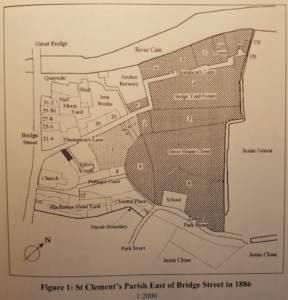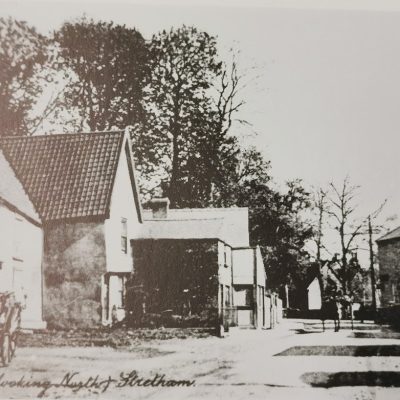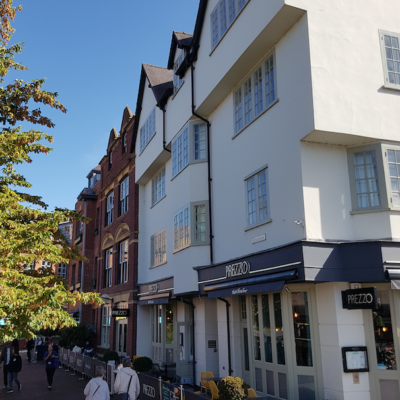Search by topic
- archaeology
- Building of Local Interest
- charity
- church
- crime
- dressmaker
- fire
- Great Eastern Railway
- Listed building
- Mapping Relief
- medieval
- oral history
- poverty
- Public House
- Rattee & Kett
- Religious House
- Roman
- scholar
- school
- Then and Now
- tudor
- women
- work
- world war one
- world war two
Search by text
Sedge Hall / The Ship
History of Sedge Hall / The Ship
The location of the ‘Ship’ in this map is the new location c.1796. The original location described below lay on the opposite side of the lane bordering the river.
According to T E Faber (An Intimate History of St Clement’s, 2006) the site of Sedge Hall seems to have retained its integrity for a longer period than other parts of the parish. In his book he calls the area between Thompson’s Lane and the river, ‘The High Bank’. In 1886 and for several centuries before that this area was divided into unequal parts by the narrow passage Quayside Lane and sources suggest that the part to the west of the lane was thought of as ‘the high bank’ while the part to the east was ‘the holm’. Most of this area is the property of Magdalene College which bought the area in 1628. In particular, since 1920, the college set about a comprehensive redevelopment of Quayside.
With reference to Sedge Hall (The Ship) Faber nots that the site is still clear in the 1886 OS map. It also has the distinction of having belong during its history to three different Cambridge colleges.
Before 1220: granted by Simon de lisle to Everard de Wynepol [Wimpole] being described as a messuage previously held by Anger son of Anger.
1260? granted by Everard’s son Martin to Robert Hubert and his wife Sabina
1280? granted by widow Sabina Hubert to her nephew John Gogging, goldsmith. First appearance of name of property ‘le Seghalle.’
bef. 1321: granted by John Gogging’s heirs to Sir John de Cambridge and his wife Joan (daughter and heiress of John Dunning).
1339 son of Sir John, Thomas, granted sedge Hall to William de Lavenham for life only. Subsequently transferred to the Gild of St Mary and then to the new college of Corpus Christi as part of a substantial endowment by Thomas to commemorate his parents. Grant refers to ‘a tenement with a quay’. the quay seems to have been a stretch of the common wharf over which the successive holders of Sedge Hall established exclusive rights. there seems to have been a building there as early as 1275 and it was not until 1544 that the town demanded a rent for the first time.
Corpus Christi 14th rentals confirm that income went to the Master initially. The following is a list of the principal lessees and sub lessees:
1370 tenant wasThomas Mabelthorpe. Rent had fallen from £6 13s 4d to £2. This was probably because of the collapse in demand for sedge after the Black Death. From 1445 the occupants of Sedge Hall seem to have become brewers in a competitive marker.
1380 – 91 John Scothouse acquires lease; he contracts to build a new house. rent £2 6s 8d.
1400 – 35 John Knapton £2
1436 – 44 Elena Belton £2 + 16s?
1445 – 57 Simon Rankyn £2
1466 – 70 William Lolleworth £2
1471 – 73 William Lolleworth’s wife £2
1476 William Dayste £2
1477 buildings sub let to two people; John Poleyne had the warehouse, Thomas Sampson the room above the warehouse.
1479 John Polyn, fisherman, granted sub lease of ‘house with solar built above it.’
1481/2 William Cappe £2: one building sub let to William Warde, baker for 13s 4d. Other to John Pawyn for ‘le Fyshouse’.
1483 the Fishhouse sub let to Richard Rawson, yeoman.
1486 Thomas Bell £2: buildings sub let to William Warde tenant of warehouse; fish house sub let to William Lorekyn (Larkyn)
1505 William Odam £3
1508 – 21 John Woodeham, brewer £4
1523 – 47 Hugh Johnson £4
1550 – 59 John Sellers £4
1562 – 63 William Hodson, brewer £2
1564 – 72 Thomas Watson, common victualler £2: ‘a tenement called ye Sedge Hall with a brewhowse thereto annexed and ye warehowse against ye pathe.’
1584 Lambert Dampes
1586 Master of Corpus decided to exchange site for agricultural land in the village of Stow-cum-Quy. New owner was the brewer Thomas Hodylowe who also rented a brewery from Jesus on the opposite bank of the river next to Magdalene College.
1595 Thomas Hodylowe (Hodilowe, Hoddilowe) died leaving substantial bequests to his children. However, Sedge Hall was handed on before his death and it became the property of Sarah Hodelowe who married c 1609 an ex-fellow of Jesus (later Bishop of Asaph) John Owen.
1607 ‘Whiteseede at ye Shipp sells beere out of doores’
1608 ‘Mr Frohock the Tayler at the Shipp’ trading in malt
1618 ‘Ship’ referred to as an inn in a town lease. Diane Haynes, widow and innkeeper.
1620 Jesus College bought property as an endowment for two scholarships. It is referred to as ‘Sedge Hall, otherwise the Ship’.
1631-41 William Gasome inn holder 1635
1656-63 Henry Curd, innholder, occupant of Sedge Hall
1664 head lease of Sedge Hall granted to John Hills by Jesus College.
1664 Francis Bird (1630-65) moved into the Ship replacing Henry Crudd who died 3/7/1664. In the plague of 1665-6 he lost four adult members and five children of his family. His wife Emma had died in February 1664 before the plague; he remarried Ann Stamford 12 June 1664. His infant daughter died August 1664, his two surviving sons died of the plague 16th Oct and 12th Nov 1665, and Francis himself died of the plague 17th Nov.
1665 Francis’s widow Ann inherited and married another carter, William Sell of Burwell in December 1666. They managed the Ship for the next 20 years or so.
1666 death of John Hill. Lease passed to son-in-law Nicholas Tabor I.
1676 Nicholas Tabor bequeathes Ship/Sedge Hall, wherein lives Sell
1683 lease renewed by younger son Nicholas Tabor II. In will of Nicholas I dated 1677 described ‘The Shipp […] called by the name of Sedghall wherin liveth Sell and [..] Cutchy in part and Mr Thompson in part and Richard Allen Waterman in part‘, and it is left to John ‘as it is now let for as long as the lease lasteth‘, ‘provided he shall have my son Nicholas Tabor have the warehouse that Richard Allen now has and the chamber over it for 40s‘ p.a. William Sell was linked by marriage to a carter called Francis Bird who was in the Ship before him. They both had a stable in the yard and their possessions were valued in 1665 and 1712 with very similar results.
1715 Phoebe Sell takes delivery from Mt Thompson of one barrel of beer which is not marked as it should be
1744-71 John later Mary, Bell for Ship in 1752
1772-88 Old Ship listed continuously
After the death of William Sell, the Ship was probably rebuilt. A photograph of 1910 just before it was demolished suggests a brick building of early 18th cent.
1771; widow of John Sparkes (John, who had leased Tassell’s garden in 1748) held lease of the Half Moon from 1763 and the sedge Hall from 1771.
1784 and 1785: two detailed plans showing in first ‘dwelling place of the Old Ship ale house‘, and in the second, ‘Sedge Hall’. This suggests that around 1784 the name and business of the Ship was transferred somewhere else nearby. T E Faber believes the house may have been lived in for a while by merchant Thomas Clarke but by 1851 the building may well have been uninhabited. Thomas Whittred and John Haggeston took over sedge Hall lease in 1785.
For a discussion about the new location of the Ship follow this link.
Contribute
Do you have any information about the people or places in this article? If so, then please let us know using the Contact page or by emailing capturingcambridge@
License
This work is licensed under CC BY-NC-SA 4.0








